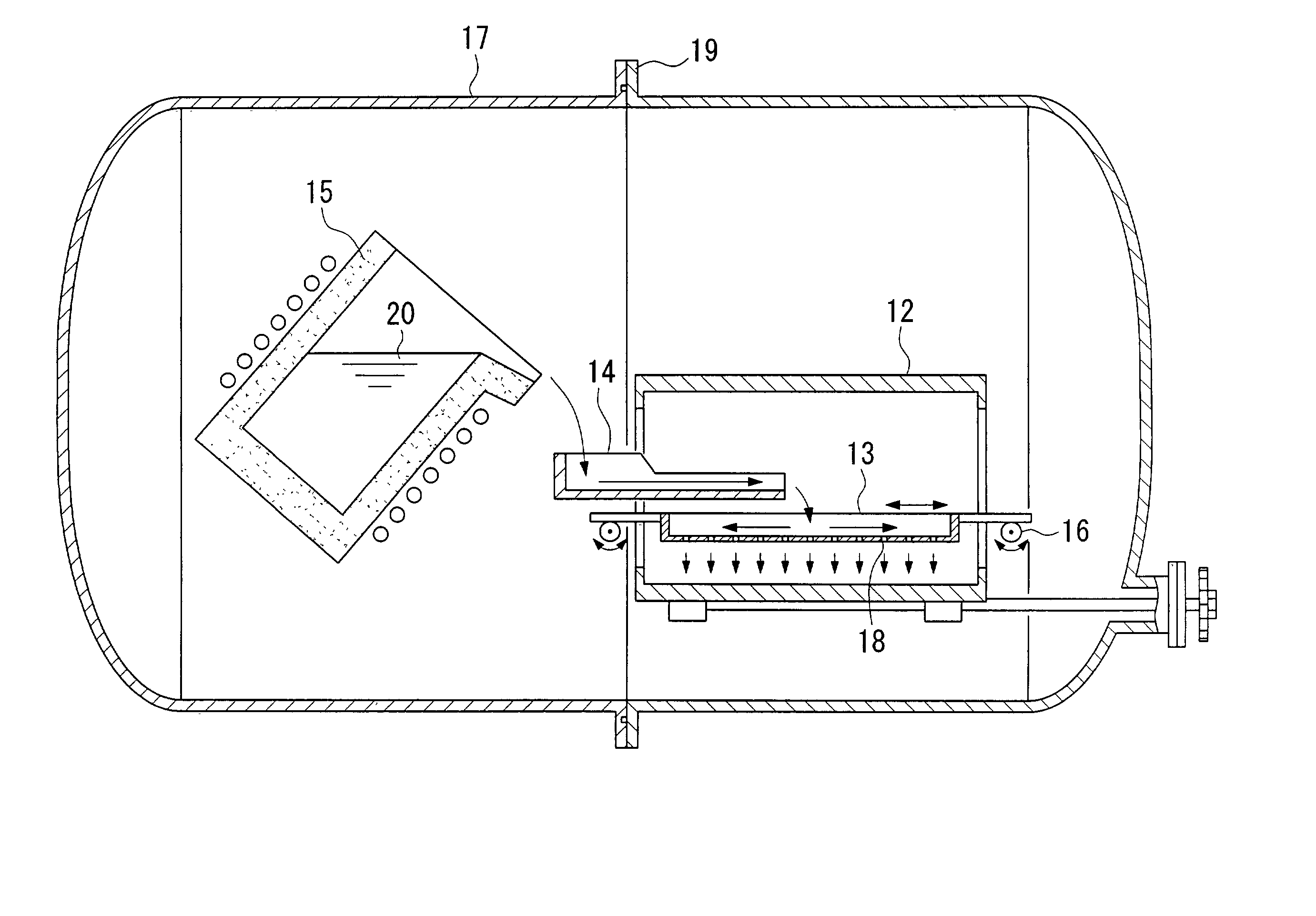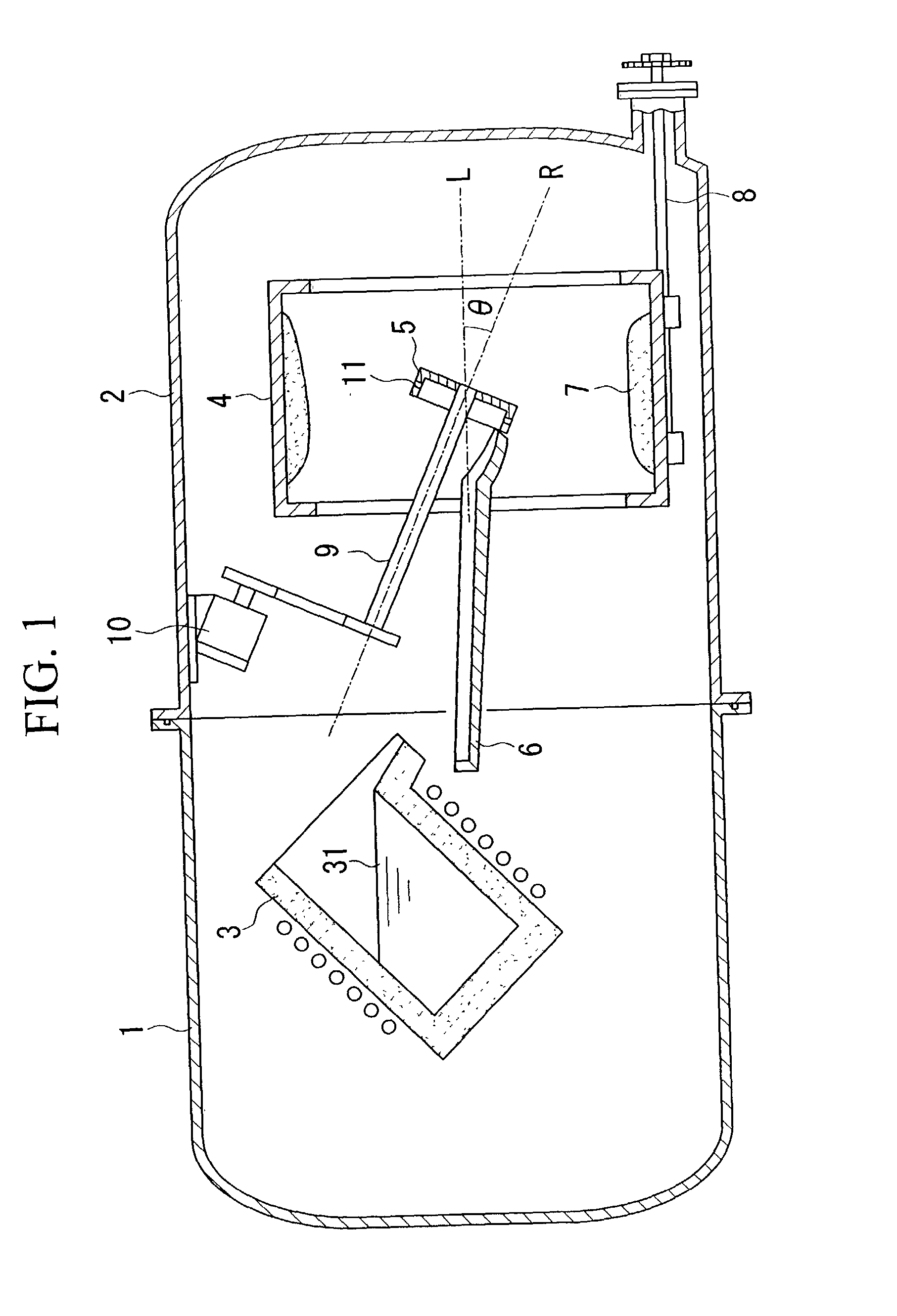Centrifugal casting method, centrifugal casting apparatus, and cast alloy produced by same
a centrifugal casting and centrifugal casting technology, which is applied in the manufacture of inductance/transformers/magnets, magnetic bodies, magnetic materials, etc., can solve the problems of cracking through grains, decrepitation of ingots into pieces, and deterioration of the crushability of alloys in the magnet production step
- Summary
- Abstract
- Description
- Claims
- Application Information
AI Technical Summary
Benefits of technology
Problems solved by technology
Method used
Image
Examples
example 1
[0178] Elemental neodymium, elemental dysprosium, ferroboron, aluminum, and electrolytic iron were weighed and mixed so as to obtain the following composition: Nd: 12.6 at. % (28.0% by mass); Dy: 0.6 at. % (1.5% by mass); B: 6.0 at. % (1.0% by mass); Al: 0.7 at. % (0.30% by mass); and a balance of iron. The resulting mixture was melted in an alumina crucible in an argon gas atmosphere by use of a high-frequency induction melting furnace. The resulting molten mixture was subjected to casting by use of the centrifugal casting apparatus shown in FIG. 1.
[0179] The cylindrical mold 4 was of an inside diameter of 500 mm and a length of 500 mm. The container-like rotary body 5 was of an inside diameter of 250 mm, and eight hole portions 11 of a 2 mm diameter were formed in the sidewall thereof. The angle of inclination .theta. formed by the axis of rotation R of the container-like rotary body 5 and the axis of rotation L of the cylindrical mold was fixed to 25 degrees during casting.
[0180]...
example 2
[0190] In order to obtain a composition in which TRE is further decreased, elemental neodymium, ferroboron, aluminum, and electrolytic iron were weighed, mixed so as to have the following composition: Nd: 12.4 at. % (28.0% by mass); B: 5.9 at. % (1.0% by mass); Al: 0.7 at. % (0.30% by mass); and a balance of iron. Casting was performed by use of an apparatus similar to that used in Example 1 under the same conditions as those of Example 1.
[0191] During casting, the container-like rotary body 5 was moved such that the angle of inclination .theta. formed by the axis of rotation R of the container-like rotary body 5 and the axis of rotation L of the cylindrical mold is varied continuously between 0 degree and 25 degrees. The average molten-material deposition rate was 0.004 cm / sec.
[0192] On the cross section of an ingot, the microstructure containing the dendritic .alpha.Fe phase occupied an area percentage of 3%, and crystal grains having an average diameter of 75 .mu.m as measured al...
example 3
[0193] In order to obtain a composition in which TRE is further decreased, elemental neodymium, ferroboron, and electrolytic iron were weighed and mixed so as to have the following composition: Nd: 11.6 at. %; B: 5.9 at. %; and a balance of iron. Casting was performed by use of an apparatus similar to that used in Example 1 under the same conditions as those of Example 1 except that the angle of inclination .theta. formed by the axis of rotation R of the container-like rotary body 5 and the axis of rotation L of the cylindrical mold was varied continuously between 0 degree and 25 degrees and that the average molten-material deposition rate was 0.003 cm / sec.
[0194] The thickness of an ingot was substantially uniform; specifically, an average of 6 mm. FIGS. 8 and 9 show back scatterd electron micrographs of a cross section of an ingot. FIG. 9 is a partially enlarged view of FIG. 8. FIG. 8 shows the generation of the gray T1 phase serving as the matrix phase, a small amount of dendritic...
PUM
| Property | Measurement | Unit |
|---|---|---|
| angle of inclination | aaaaa | aaaaa |
| angle | aaaaa | aaaaa |
| deposition rate | aaaaa | aaaaa |
Abstract
Description
Claims
Application Information
 Login to View More
Login to View More - R&D
- Intellectual Property
- Life Sciences
- Materials
- Tech Scout
- Unparalleled Data Quality
- Higher Quality Content
- 60% Fewer Hallucinations
Browse by: Latest US Patents, China's latest patents, Technical Efficacy Thesaurus, Application Domain, Technology Topic, Popular Technical Reports.
© 2025 PatSnap. All rights reserved.Legal|Privacy policy|Modern Slavery Act Transparency Statement|Sitemap|About US| Contact US: help@patsnap.com



